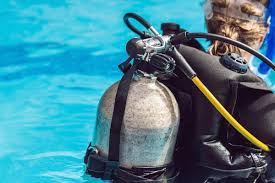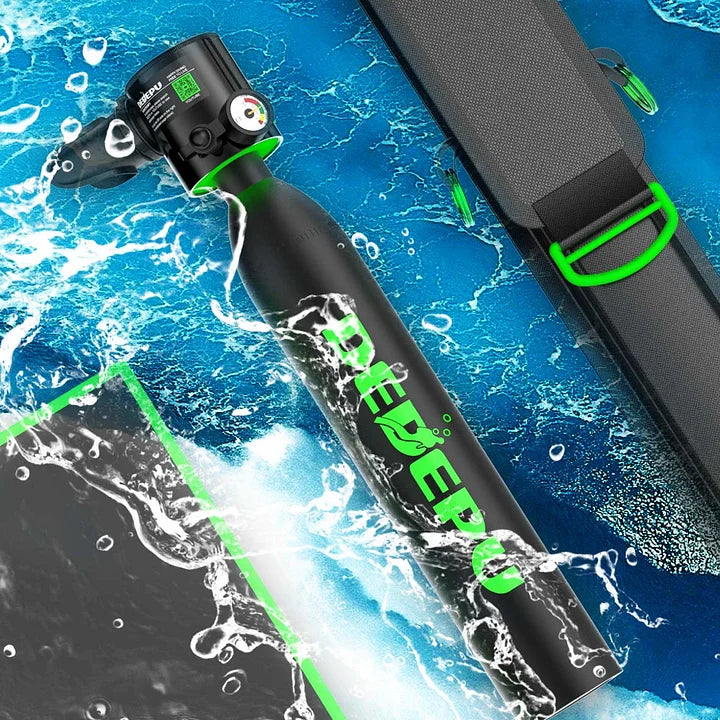Divers carry oxygen cylinders, technically called scuba tanks, to breathe underwater since humans cannot extract oxygen from water like fish. These tanks typically contain compressed air (21% oxygen, 78% nitrogen) or enriched air (up to 40% oxygen for deeper dives), allowing divers to stay submerged for 30-60 minutes depending on depth and activity. Without them, diving beyond shallow depths would be impossible due to pressure and lack of breathable air.
How Breathing Works Underwater
A standard scuba tank holds 12 liters of air at 200 bar pressure, providing roughly 30-60 minutes of breathing time depending on depth and exertion. The deeper you go, the faster you consume air due to increased pressure—at 30 meters, a diver breathes 4 times faster than at the surface.
The air inside a scuba tank is typically 21% oxygen and 78% nitrogen, similar to what we breathe on land. However, for deeper dives (beyond 40 meters), divers may use nitrox (32-40% oxygen) to reduce nitrogen absorption and lower the risk of decompression sickness. Without a tank, a free diver (holding their breath) can only stay submerged for 2-5 minutes, while scuba divers can explore for much longer with proper air supply.
| Factor | Free Diver (No Tank) | Scuba Diver (With Tank) |
|---|---|---|
| Max Depth | 20-40 meters | 40+ meters (with training) |
| Breathing Time | 2-5 minutes | 30-60 minutes |
| Gas Mixture | None (holds breath) | Air (21% O₂) or Nitrox (32-40% O₂) |
At 10 meters, the pressure is 2x surface level, meaning each breath draws twice as much air from the tank. That’s why divers monitor their air consumption rate (ACR), usually 20-25 liters per minute during moderate activity.
Another critical factor is buoyancy control. A full scuba tank weighs 12-18 kg, making the diver negatively buoyant at first. As air is consumed, buoyancy increases, requiring adjustments via a buoyancy compensator (BC) device. If a diver ascends too quickly, the expanding air in their lungs can cause injury—which is why exhaling slowly during ascent is crucial.
What's Inside the Tank
Most recreational tanks contain compressed air, which is nearly identical to what we breathe on land: 78% nitrogen, 21% oxygen, and 1% trace gases. This mix works safely down to about 40 meters. For deeper dives, technical divers use enriched air nitrox (EANx), blending 32-40% oxygen to reduce nitrogen buildup and extend bottom time.
The air inside a standard aluminum 80-cubic-foot tank (the most common recreational size) is compressed to 200-300 bar (2,900-4,350 psi), packing roughly 2,300 liters of breathable air at surface pressure. That’s enough for 45-60 minutes at 10 meters, but consumption spikes with depth—at 30 meters, a diver breathes 4x faster due to pressure, cutting dive time to just 15-20 minutes.
Here’s how gas behaves inside the tank:
- At 200 bar, the air molecules are packed so tightly that a single breath at the surface (0.5 liters) expands to 2 liters when inhaled at 10 meters (2 bar pressure).
- Oxygen toxicity becomes a risk if partial pressure exceeds 1.4 bar, which is why recreational divers avoid oxygen levels above 40%.
- Nitrogen narcosis starts affecting judgment at 30+ meters, where the nitrogen partial pressure reaches 3.1 bar, creating a "martini effect" similar to alcohol intoxication.
Technical divers sometimes use trimix, replacing some nitrogen with helium to reduce narcosis below 40 meters. A typical trimix blend might be 18% oxygen, 45% helium, and 37% nitrogen for a 60-meter dive. Helium transfers heat 6x faster than air, so divers in cold water lose body temperature rapidly unless wearing proper thermal protection.
A standard aluminum tank weighs 14 kg empty and 17 kg when filled, while steel tanks (favored for their negative buoyancy) weigh 12-16 kg empty but can hold more gas due to higher pressure ratings (up to 300 bar). Every tank undergoes hydrostatic testing every 5 years to check for metal fatigue, and visual inspections every year to spot corrosion or cracks.
Dive shops use oxygen-compatible compressors (costing 10−15 more than regular air due to the extra filtration and testing required.
In wreck or cave diving, where air supply is critical, divers often carry dual tanks or a main tank plus a smaller "pony bottle" (3-6 liters) as backup. A 6-liter pony bottle at 200 bar holds 1,200 liters—enough for 5-7 minutes of emergency breathing at 20 meters, which could mean the difference between life and death during an out-of-air scenario.

How Long It Lasts
A standard aluminum 80-cubic-foot scuba tank might seem like it holds endless air, but in reality, its duration depends on multiple factors. At rest on the surface, an average adult breathes about 8 liters of air per minute. But at 10 meters underwater, where pressure doubles, that same breath consumes 16 liters from the tank. Most recreational divers with normal breathing patterns can expect 45-60 minutes from a full tank at shallow depths, while aggressive swimming or deeper dives can slash that time to 20 minutes or less.
A typical 80-cu-ft tank contains approximately 2,300 liters of compressed air when filled to 200 bar. Divide that by a diver's surface air consumption rate (SAC rate), which ranges between 12-25 liters per minute for most people, and you get the baseline duration. However, this changes dramatically with depth. At 20 meters (3 atmospheres absolute), each breath pulls three times as much air from the tank compared to the surface. A diver with a SAC rate of 20 liters per minute on land would burn through 60 liters per minute at this depth, reducing a full tank's supply to just 38 minutes even without physical exertion.
Proper buoyancy control can reduce air consumption by 15-20%, and slow, deep breathing patterns help. Cold water also plays a role—a 10°C drop in water temperature increases metabolic rate by 5-7%, causing faster breathing. Divers in tropical waters typically get 10-15% more bottom time from the same tank compared to those in colder environments.
A set of twin 12-liter steel tanks filled to 230 bar holds nearly 5,500 liters of gas, allowing 90+ minutes at moderate depths. Rebreather systems take this further by recycling exhaled gas, offering 3-6 hours of dive time, but these systems cost $5,000−15,000 and require extensive training.
A diver at 30 meters with 50 bar remaining has only about 5 minutes of air left if ascending normally—less if stressed. That's why divers follow the rule of thirds: use one-third of the air for descent, one-third for exploration, and keep one-third in reserve for ascent and emergencies.
A compact 6-liter pony bottle, often used as backup, holds just 1,200 liters—enough for 5-7 minutes at 20 meters during an out-of-air emergency. Meanwhile, commercial divers using surface-supplied systems can stay underwater indefinitely, with compressors pumping fresh air through umbilical hoses at 40-60 liters per minute.
While an 80-cu-ft aluminum tank gives most recreational divers 45-60 minutes in warm, shallow waters, pushing limits cuts that time drastically. Smart divers plan dives around their air supply, not the other way around.
Why Not Just Hold Breath
Free divers—who rely solely on breath-holding—can typically stay submerged for 2-5 minutes, with elite athletes pushing to 10 minutes under perfect conditions. But scuba diving while holding your breath is dangerous and can lead to lung overexpansion injuries, which is why certified divers are trained to never do it.
At 10 meters depth, the water pressure doubles compared to the surface, compressing air in the lungs to half its original volume. If a diver takes a full breath at the surface (about 6 liters for an average adult), holds it, and descends to 10 meters, that air shrinks to 3 liters. But during ascent, the reverse happens—the air expands back to its original volume. If a diver panics and doesn’t exhale, the lungs can rupture at just 1.5 meters depth as the air inside them expands beyond their 6-liter capacity. This is called pulmonary barotrauma and can force air into the bloodstream, causing strokes or heart attacks.
Their spleen contracts to release extra oxygen-carrying red blood cells, and their heart rate can drop below 30 beats per minute to conserve oxygen. Even with these adaptations, most free dives last less than 3 minutes, and depths beyond 40 meters require years of training. By comparison, a scuba diver with a standard tank can comfortably explore at 20 meters for 40 minutes without any physiological strain.
At rest, humans tolerate up to 50 mmHg of CO₂ before the breathing reflex becomes overwhelming. During exercise, this threshold drops to around 35 mmHg—meaning a swimming diver will feel the need to breathe much sooner than one lying still. Scuba gear solves this by continuously flushing CO₂ away with each exhale, while free divers must endure the burning sensation until surfacing.
Blackout risk is highest in the final 10 meters of ascent during free diving. As pressure decreases, oxygen partial pressure drops rapidly, sometimes below the level needed to maintain consciousness (around 0.16 bar). An estimated 1 in 500 recreational free dives results in loss of consciousness, usually without warning. Scuba divers avoid this by maintaining a constant oxygen supply and ascending slowly enough to off-gas excess nitrogen.
Different Tanks for Different Dives
Recreational divers typically use aluminum 80-cubic-foot tanks (14 kg empty), providing 50-60 minutes at 10 meters. Technical divers exploring wrecks or caves often carry twin 12-liter steel tanks (22 kg each), offering 120+ minutes at 30 meters. The choice impacts buoyancy, trim, and decompression obligations.
Aluminum tanks dominate recreational diving due to affordability ($250–400 new) and corrosion resistance. The standard AL80 holds 11.1 liters at 207 bar (2,300 liters of air)—sufficient for most warm-water dives. However, they shift buoyancy by 2.5 kg as air depletes, requiring constant adjustment. Steel tanks solve this by remaining negatively buoyant when empty. A high-pressure steel 12-liter tank (300 bar) holds 3,600 liters (56% more than AL80) while weighing just 16 kg.
Nitrox divers (32–40% oxygen) gain 15–30% longer no-decompression limits, but tanks require special cleaning and labeling. Technical dives below 40 meters demand trimix (oxygen/helium/nitrogen), with 20–50% helium preventing nitrogen narcosis. An 18/35 trimix (18% oxygen, 35% helium) for 60-meter dives costs 100–200 to fill twin tanks.
Below 10°C, standard air risks regulator freezing from moisture expansion. Dry-suit divers often use dedicated argon tanks (better insulation) for suit inflation, separate from breathing gas. Saturation divers rely on 50-liter helium-oxygen banks with gas recycling systems for weeks-long habitat stays.





Leave a comment
All comments are moderated before being published.
Este site está protegido pela Política de privacidade da hCaptcha e da hCaptcha e aplicam-se os Termos de serviço das mesmas.